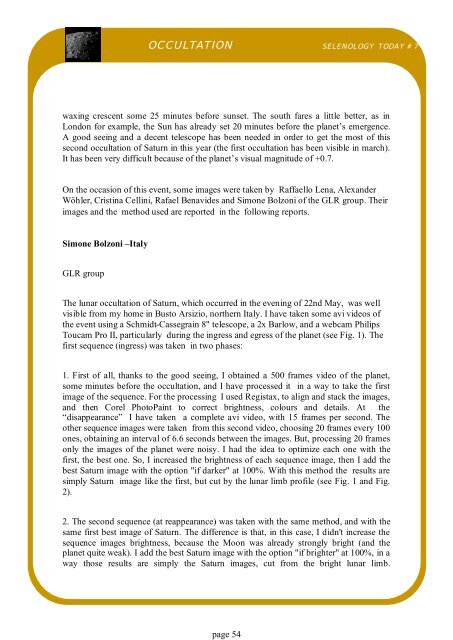Selenology Today # 7 July 2007 - Home
Selenology Today # 7 July 2007 - Home
Selenology Today # 7 July 2007 - Home
You also want an ePaper? Increase the reach of your titles
YUMPU automatically turns print PDFs into web optimized ePapers that Google loves.
OCCULTATION SELENOLOGY TODAY # 7<br />
waxing crescent some 25 minutes before sunset. The south fares a little better, as in<br />
London for example, the Sun has already set 20 minutes before the planet’s emergence.<br />
A good seeing and a decent telescope has been needed in order to get the most of this<br />
second occultation of Saturn in this year (the first occultation has been visible in march).<br />
It has been very difficult because of the planet’s visual magnitude of +0.7.<br />
On the occasion of this event, some images were taken by Raffaello Lena, Alexander<br />
Wöhler, Cristina Cellini, Rafael Benavides and Simone Bolzoni of the GLR group. Their<br />
images and the method used are reported in the following reports.<br />
Simone Bolzoni –Italy<br />
GLR group<br />
The lunar occultation of Saturn, which occurred in the evening of 22nd May, was well<br />
visible from my home in Busto Arsizio, northern Italy. I have taken some avi videos of<br />
the event using a Schmidt-Cassegrain 8" telescope, a 2x Barlow, and a webcam Philips<br />
Toucam Pro II, particularly during the ingress and egress of the planet (see Fig. 1). The<br />
first sequence (ingress) was taken in two phases:<br />
1. First of all, thanks to the good seeing, I obtained a 500 frames video of the planet,<br />
some minutes before the occultation, and I have processed it in a way to take the first<br />
image of the sequence. For the processing I used Registax, to align and stack the images,<br />
and then Corel PhotoPaint to correct brightness, colours and details. At the<br />
“disappearance” I have taken a complete avi video, with 15 frames per second. The<br />
other sequence images were taken from this second video, choosing 20 frames every 100<br />
ones, obtaining an interval of 6.6 seconds between the images. But, processing 20 frames<br />
only the images of the planet were noisy. I had the idea to optimize each one with the<br />
first, the best one. So, I increased the brightness of each sequence image, then I add the<br />
best Saturn image with the option "if darker" at 100%. With this method the results are<br />
simply Saturn image like the first, but cut by the lunar limb profile (see Fig. 1 and Fig.<br />
2).<br />
2. The second sequence (at reappearance) was taken with the same method, and with the<br />
same first best image of Saturn. The difference is that, in this case, I didn't increase the<br />
sequence images brightness, because the Moon was already strongly bright (and the<br />
planet quite weak). I add the best Saturn image with the option "if brighter" at 100%, in a<br />
way those results are simply the Saturn images, cut from the bright lunar limb.<br />
page 54


